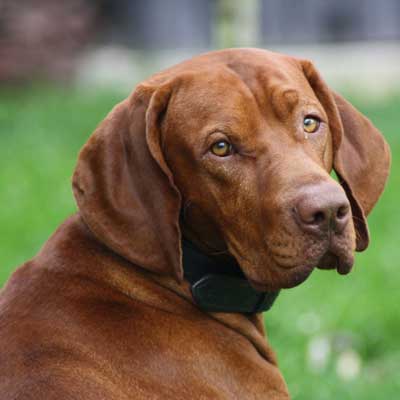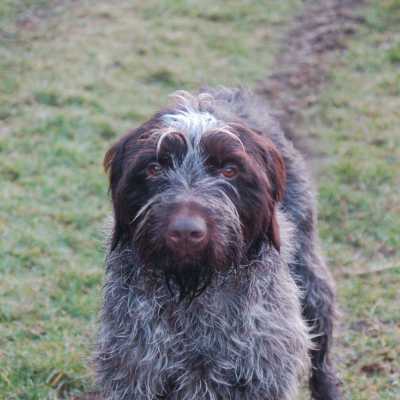Hungarian Short-Haired Pointer (Vizsla)
Easy going and adaptable, he is a great companion
-
Head
Dry, noble, well proportioned -
Head - skull region
Skull: Moderately wide, slightly domed. A slightly pronounced
groove runs from the moderately developed occiput towards the stop.
The superciliary ridges are moderately developed.
Stop: Moderate. -
Head - facial region
Nose: Well developed and broad with nostrils as wide as possible.
The colour of the nose harmonises in a dark shading with the coat
colour.
Muzzle: Blunt, not pointed; with strong jaws, strongly muscled. The
bridge of the nose is straight.
Lips: Tightly fitting, no pendulous flews.
Jaws/Teeth: Powerful jaws with a perfect, regular and complete
scissor bite, the upper teeth closely overlapping the lower teeth and set square to the jaws; with 42 healthy teeth according to the
dentition formula.
Cheeks: Strong, well muscled.
Eyes: Slightly oval, of medium size. Well fitting eyelids. Intelligent and lively expression. The brown eye harmonising with the coat colour, as dark as possible preferred.
Ears: Leathers set on at medium height, a little backwards. Fine
leathers hanging closely to the cheeks, ending in a rounded V shape.
The length is about three quarters of the length of the head. -
Neck
Of medium length, harmonising with the overall appearance.
The nape very muscular and slightly arched. Tightly fitting skin at
the throat. -
Body
Withers: Pronounced and muscular.
Back: Solid, strong, well muscled, taut and straight. The vertebral
spines should be hidden by the muscles.
Loin: Short, broad, tight, muscular, straight or slightly arched. The portion from back to loin is well coupled.
Croup: Broad and of sufficient length, not cut off short. Sloping
slightly to the tail. Well muscled.
Chest: Deep and broad with well developed, well muscled, moderately arched forechest; sternum extending as far back as possible. The sternum and the elbow should be at the same level.
Ribs moderately arched. Last ribs carried well back.
Underline: Elegant, tight, arching line towards the rear, slightly tucked up. -
Tail
Set on slightly low, strong at the base, then tapering. In
countries where tail docking is not prohibited by law, the tail may be shortened by one quarter to avoid hunting hazards. If tail docking is prohibited, the tail reaches down to the hock joint and carried straight or slightly sabre like.
On the move, it is raised up to the horizontal. It is well covered by dense coat. -
Forequarters
General appearance: Viewed from the front, straight and parallel.
Viewed from the side, legs are vertical and placed well under the
body. Good bones, strongly muscled.
Shoulders: Long, sloping and flat, well attached shoulder blade.
Flexible. Strong, dry musculature. Well angulated between shoulder blade and upper arm.
Upper arm: As long as possible. Well muscled.
Elbows: Fitting close to the body, however not tied in, turning
neither in nor out. Well angulated between upper arm and forearm.
Forearm: Long, straight, sufficiently muscled. Bone strong, but not coarse.
Pastern joint: Strong, tight.
Pastern: Short, only very slightly sloping.
Forefeet: Slightly oval, with well knit, sufficiently arched, strong toes. Strong brown nails. Tough, resistant, slate grey pads. The feet
are parallel when standing or moving. -
Hindquarters
General appearance: Viewed from behind, straight and parallel. Well angulated. Strong bone.
Upper thigh: Long and muscular. Good angulation between pelvis and upper thigh.
Stifle: Well angulated
Lower thigh: Long, well muscled and sinewy. Its length is almost equal to that of the upper thigh. Good angulation between lower thigh and metatarsus.
Hock joint: Strong, dry and sinewy, rather well let down.
Metatarsus: Vertical, short and dry.
Hind feet: Similar to forefeet. -
Gait / Movement
The typical gait is an animated, light-footed
trot, elegant and far reaching, with much drive and corresponding
reach. Not exhausting gallop when working in the field. The back is firm and the topline remains level. Good, upright carriage. Pacing undesirable. -
Skin
Tightly fitting, without folds. The skin is well pigmented. -
Coat - hair
Short and dense, should be coarse and hard at the touch. On the head and the leathers, it should be thinner, silkier and shorter. The hair underneath the tail should be slightly, but not noticeably, longer.
It should cover all of the body; the underside of the belly is a little lighter coated. No undercoat. -
Coat - colour
Various shades of russet gold and dark sandy gold (semmelgelb). The leathers may be a little darker, otherwise uniform in colour. Red, brownish or lightened colour is undesirable. A little white patch on the chest or at the throat, not more than 5 cm in diameter, as well as white markings on the toes are not considered faulty. The colour of the lips and the eyerims corresponds to the
colour of the nose. -
Size
Height at withers: Dogs: 58 - 64 cm
Bitches: 54 - 60 cm
It is ineffective to increase the height at the withers. A medium size should be aimed at. Overall balance and symmetry are much more important than the mere measurable size. -
Faults
Any departure from the foregoing points should be considered a fault and the seriousness with which the fault should be regarded should be in exact proportions to its degree and its effect upon the health and welfare of the dog. -
Disqualifying faults
• Aggressive or overly shy dogs.
• Any dog clearly showing physical or behavioural abnormalities.
• Distinct deviations from the characteristics of the breed.
• Strong deviation from the sexual characteristics.
• Atypical head.
• Spotted(butterfly) nose
• Pendulous or dribbling flews.
• Under- or overshot mouth. Wry mouth, including all
intermediate forms.
• One or more missing incisors and/or canine and/or premolars 2-4
and/or molars 1-2; more than two missing PM1; the M3 are
disregarded. Not visible teeth are assessed as missing ones.
Supernumerary teeth not in line with the o-others.
• Cleft palate, harelip.
• Light yellow eyes. Very loose eyelids; ectropion, entropion.
Distichiasis (double row of eyelashes).
• Pronounced dewlap.
• Dewclaws.
• Very faulty movement.
• Atypical coat.
• Dark brown or pale yellow colour. Parti-coloured, not uniformly coloured. White chest patch larger than 5 cm.
• White feet.
• Lacking pigmentation either on the skin or on the lips and eyerims.
• Deviation of more than 2 cm from the above, mentioned heights at withers.






